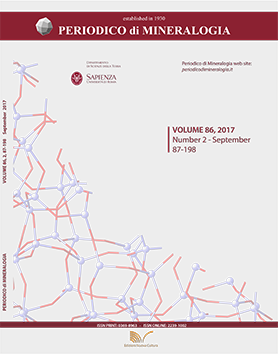Geochemistry and tectonic setting of triassic magmatism from the Lercara Basin (Sicily, Italy)
DOI:
https://doi.org/10.2451/2017PM725Keywords:
Lercara Basin, intraplate continental volcanism, dikes, SEM-EDS, XRF, spinel-garnet-lherzolite sourceAbstract
Petrological and geochemical data of Triassic magmatic rocks from Lercara Basin(Central Sicily), are discussed to provide new information about the intraplatevolcanism related to the Pangea break up. The magmatic rocks crop out as subvolcanicbodies and are packed in several Lower Triassic clayey lithologies correlated to thesedimentation into the Imerese and Sicano domains. The samples were divided in twogroups. The first group includes transitional to alkaline basalts, with crystalline sub-ophitic texture mainly characterized by plagioclase, clino- and orthopyroxene, andolivine crystals. The second group includes more altered rocks, with porphyritic texture,showing alkali basaltic to phonolitic compositions. Major and trace element data ofsingle groups show small variations indicating fractional crystallization processes.Abundances and ratios of incompatible trace elements indicate that rocks were formedin an intraplate continental environment from different mantle sources with E-MORB toOIB-type compositions. Low degrees of partial melting at the transition between spineland garnet lherzolite fields can be hypothesized for parental magmas of the LercaraBasin. Magmas ascended to the surface as various batches of magmas along lithosphericfractures originated by flexure and uplift of the Mesozoic Pangea supercontinent.


